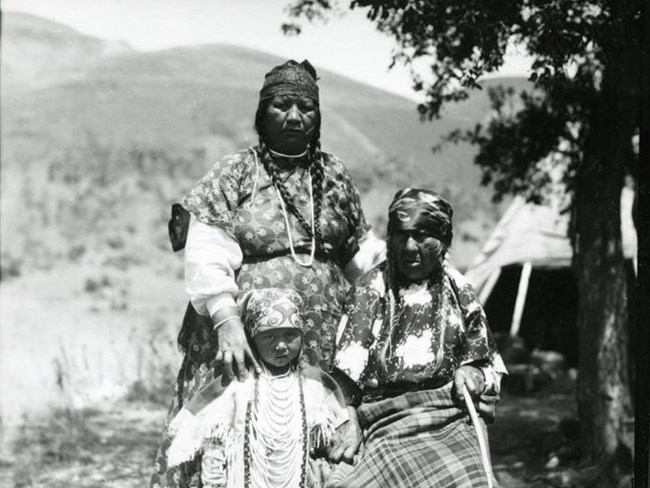Part of a series of articles titled Women's History in the Pacific West - Columbia-Pacific Northwest Collection.
Previous: Maria Keawea Maki
Next: Catherine O'Byrne
Article

Washington State University Manuscripts, Archives & Special Collections, Photographer Alonzo V. Lewis
Article Written By Yutong Zhan
Decades after the Battle of Big Hole in Montana in 1877, Nez Perce woman Penahwenonmi (Helping Another, 1840-1938) remembered vividly the atrocities of the war. “I hid under some willow brush.... A little girl lay close, my arm over her. Bullets cut twigs down on us like rain. The little girl was killed. Killed under my arm,” as Penahwenonmi told Lucullus Virgil McWhorter, a white Ohio farmer who in the early twentieth century set out to collect Nez Perce testimonies of the Nez Perce War.1 Penahwenonmi’s words challenge the perceived masculine nature of warfare and remind us that women’s experiences were an integral part of the story. Nez Perce women’s suffering and resilience left important marks on the land where the Big Hole National Battlefield stands.
The Battle of Big Hole was one of the critical battles of the Nez Perce War of 1877 (also known as the Flight of 1877). Referring to themselves as Nimíipuu (the Real People), the Nez Perce lived on land that spanned more than twenty-five thousand square miles in what is now southeastern Washington, northeastern Oregon, and north-central Idaho.2 The Treaty of 1855 confined the Nez Perce to a reservation, and they experienced further loss of land upon the signing of the Treaty of 1863.3 The dispossession and forced removal eventually contributed to armed conflict between the Nez Perce and the United States Army in 1877.4 The Battle of Big Hole took place on August 9 -10, 1877 when the Nez Perce fled their homes and embarked on the Lolo Trail to reach Montana.5 Nez Perce women and children traveled with the warriors on this journey. Although they generally did not engage in combat, Nez Perce women played a critical role during the war. They set up and maintained the lodges, prepared food, and gathered wood as they delivered food, water, and horses to the battlefield and cared for the wounded.6
Surviving the Battle of Big Hole—a bloody war that brought about tremendous losses to Nez Perce people, Nez Perce women like Penahwenonmi witnessed and lived through suffering.7 However, suffering was not the whole story of Nez Perce women at Big Hole. Penahwenonmi recounted that in one rare incident, a Nez Perce woman, wife of Wahlitits (Shore Crossing), took up arms and fought back.8 After a U.S. soldier killed Wahlitits, his wife, though being wounded herself, “grabbed up his gun and shot this soldier, killing him.”9 “When several soldiers fired at her, she dropped dead,” Penahwenonmi said, “she was soon to become a mother.”10 Despite the atrocities of war, Nez Perce women proved to be resilient. Over the course of three months and about 1,200 miles, they continued to shoulder the day-to-day tasks as the Nez Perce moved toward Montana.11 As an unnamed Nez Perce woman commented, “without the women being strong for the people, we would no longer exist, because it took their strength to keep the people going.”12
The Battle of Big Hole was one episode in the long history of U.S. territorial expansion and post-Civil War extension of federal power to the trans-Mississippi West.13 Nez Perce women lived through these tumultuous years. They witnessed the brutalities of warfare and experienced tremendous loss and suffering, but they also demonstrated the resilience of the Nez Perce people. Their stories shed light on the violent process of dispossession, the long-lasting impact of which Indigenous people have continued to grapple with.
Author's Note: this biography relies entirely on sources collected and conserved by non-Indigenous observers. These mediated texts are inherently colonized documents; they cannot fully embody Indigenous perspectives and may be inaccurate.
This project was made possible in part by a grant from the National Park Foundation.
This project was conducted in Partnership with the University of California Davis History Department through the Californian Cooperative Ecosystem Studies Unit, CA# P20AC00946
1 Lucullus Virgil McWhorter, Yellow Wolf: His Own Story (Caldwell: Caxton Press, 1940), 136. According to historian Steven Ross Evans, McWhorter was “deeply affected by his growing friendship with Yellow Wolf” and “saw the need to record Nez Perce accounts of their history” (20). McWhorter’s subsequent collection of oral accounts from Yellow Wolf and his extended family served as an important foundation for the revision of the false views of Nez Perce people and for “chronicling a new history of the Nez Perces” (21). For more information on McWhorter, see Steven Ross Evans, Voice of the Old Wolf: Lucullus Virgil McWhorter and the Nez Perce Indians (Pullman: Washington State University Press, 1996).
2 Elliott West, The Last Indian War: The Nez Perce Story (New York: Oxford University Press, 2009), 5.
3 Caroline James, Nez Perce Women in Transition, 1877-1990 (Moscow: University of Idaho Press, 1996), 4.
4 James, Nez Perce Women in Transition, 123.
5 West, The Last Indian War, 165, 186. Also known as K'useyneisskit (Road to the Buffalo), Lolo Trail was designated a National Historic Landmark in 1960. It is also part of the Nez Perce National Historic Trail. See https://www.nps.gov/nepe/learn/historyculture/lolo-trail-and-pass-history.htm.
6 James, Nez Perce Women in Transition, 123, 125.
7 West, The Last Indian War, 186.
8 McWhorter, Yellow Wolf, 136.
9 McWhorter, Yellow Wolf, 136
10 McWhorter, Yellow Wolf, 136.
11 Kim Briggeman, “Overlooked: Roles of Nez Perce women and children in 1877 War Important and Poignant,” Missoulian, August 5, 2017, https://missoulian.com/news/local/overlooked-roles-of-nez-perce-women-and-children-in-1877-war-important-and-poignant/article_5b3aed4a-5891-592a-a34f-1ecb9f329226.html.
12 James, Nez Perce Women in Transition, 133.
13 West, The Last Indian War, xxi-xxii.
Part of a series of articles titled Women's History in the Pacific West - Columbia-Pacific Northwest Collection.
Previous: Maria Keawea Maki
Next: Catherine O'Byrne
Last updated: December 30, 2022